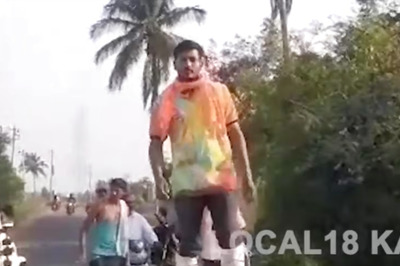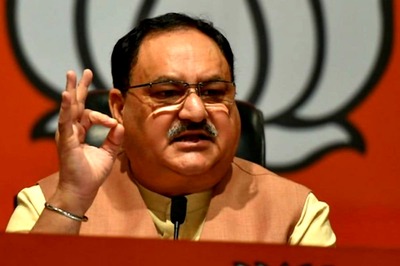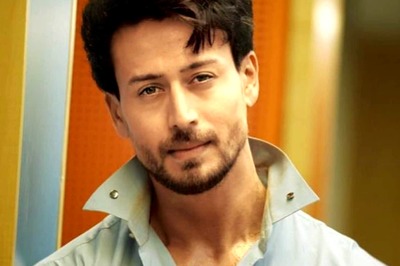
views
On October 31, 1984, Sanjay Suri, a reporter with 'The Indian Express' was having breakfast at his house in South Delhi. A friend in the police called him up to say that Prime Minister Indira Gandhi had been shot by her bodyguards. “Pata kar," he said in Punjabi, "Indira nu goli vajji ay.” (Indira has been shot).
In the violence that followed over the next three days nearly 3000 Sikhs were killed across Delhi and other cities in the country. Suri, who covered the anti-Sikh violence, gives a first person account of seeing Kamal Nath, then a Congress MP, exercising control over a mob that had gathered at the Gurudwara Rakab Ganj in the national capital. The details are also given in the book (1984: The Anti-Sikh Violence and After) which Suri later wrote.
Suri is now CNN-News18's Editor, Europe.
Kamal Nath had come to Rakab Ganj gurdwara from Teen Murti Bhavan that afternoon of November 1, 1984.
Teen Murti was where Indira Gandhi’s body lay in state. She was assassinated the morning of October 31.
She was taken to the All India Institute of Medical Sciences, but she had died on the spot where she was shot by her bodyguards.
Everyone seemed to have heard of the assassination soon after, even in that pre-Internet era, well before the official announcement that came only later that evening of the 31st.
The body was kept in state for mourners to file past. That scene was being broadcast live on the government-owned Doordarshan Television. What the nation saw - what the nation was being shown by the government of the day - was far less an expression of mourning than a call to murder.
“Khoon ka badla khoon se lenge”, “Khoon ka badla khoon”, column after column of men filing past the body screamed, and they were live on television.
They acted on their calls to kill, almost immediately. They headed out to Rakab Ganj, the nearest gurdwara to Teen Murti Bhavan – a fact evident from police records of crowd movements.
The police had switched off from policing all over Delhi, barring some exceptions, very few exceptions, but crowd movements were being reported and recorded over the police wireless network.
The case against the police those days rests on these two sets of recorded facts – what the records show the police knew, and what the records show the police then failed to do in the face of that knowledge.
At Rakab Ganj, at least two Sikhs were burnt alive. Far more were being killed of course in other areas of the city, mainly in East Delhi and west Delhi.
I had set out reporting on my scooter that morning, as the crime reporter of The Indian Express newspaper.
I followed columns of smoke, the most reliable guide I could find at first to what was happening to the city. That, and some alerts informally shared by friends in the police led me to Rakab Ganj gurdwara.
By the time I reached the gurdwara, those two Sikhs had already been killed. A large mob was surging towards the gurdwara again and again.
I saw Kamal Nath towards the front of that crowd, a little to a side.
And by his side, perhaps a platoon of Central Reserve Police Force (CRPF) policemen standing in neat formation, watching the mob advance on and on towards the gurdwara.
This was not just some threatening mob, it was a murderous mob, these people had killed, within sight of that police force.
The police were given no orders to search out the killers, or to stop or scatter the mob. They just stood and watched, from front row position.
A top police officer was on the scene, leading the police spectators.
Additional commissioner of police of New Delhi range, Gautam Kaul, stood carrying a bamboo shield by the side of the police force, heading the police watching the mob. Delhi was divided into two ‘ranges’ for police purposes, and within those, into six police districts.
South Delhi, New Delhi and West Delhi were in New Delhi range, and East Delhi, North Delhi and Central Delhi fell within Delhi range.
Gautam Kaul was second only to the Commissioner of Police in his area, and so this police idleness in the direct face of murder, in the face of an advancing mob threatening yet more, was being commanded by the number two in Delhi Police present at the scene for dealing with the unfolding violence.
Management of the crowd, I could see, had been left to Kamal Nath. I spell out what I saw in an account in my book [1984 – The Anti-Sikh Violence and After, HarperCollins, 2015].
I raise several questions over Kamal Nath’s presence and positioning at that scene, which itself seemed to betray a connection.
Did I see Kamal Nath lead a mob Bollywood-style, commanding them to kill Sikhs, in some obvious and physical way?
No, I did not. In fact, what I did see was that at one point the mob rushed up yet again towards the gurdwara, Kamal Nath had only to gesture lightly, and they held back. Kamal Nath said later he was only trying to control the situation.
But it was clear that Kamal Nath and that crowd had a connection; he signalled, they listened.
And they would only respond to him if they were from the Congress party and accepted him as their leader. Kamal Nath, as I said in my affidavit before the Mishra Commission, had control over them.
I raise again below some questions about Kamal Nath’s presence at Rakab Ganj gurdwara that I raise in the book
1) Why was the crowd listening to Kamal Nath? Why in a situation where a murderous crowd was advancing yet again, would the police continue to stand to a side (and the officer leading them duck to a side) but a word from a Congress MP become more effective than any move from the police? What was the relation between Kamal Nath and that crowd that he had only to raise his hand towards them and they held back?
2) Could these have been just people with no party connections who had seen an MP shoo them back, and had gone back as a result because they held such innate respect for an MP, just any MP? They did not appear like a lot who had killed, who were now out to kill more, but would suddenly hold back because just any leader, and not their particular leader, had signalled them to hold back.
3) Why was the move to control left to Kamal Nath? Was that not for the police to do? And if Kamal Nath was on the scene as a responsible political leader, as he said he was, would it not be proper for him to do all he could to make sure that the police dealt with the situation? Instead, he was there in direct communication with the crowd, with the police idle to a side.
4) If Kamal Nath was playing a role as responsible citizen and leader, he would have pushed the local police later for investigation of the murders committed right there, and for prosecution of the guilty. We have seen no evidence that he made any firm move to that end. He was controlling the people his way; this was not the legal way.
5) What did the police themselves know about the mob, and who the mob were made of, that they could decide to stand back and place the situation in the hands of the Congress-I MP Kamal Nath? And then choose not to lift a hand against the mob?
I do raise the likelihood in my account in the book that in failing to push for police intervention at that scene Kamal Nath may actually have contributed to the creation of a situation where more murders would be committed.
Because those men at Rakab Ganj were left free to kill yet more Sikhs – carrying a very loud message delivered by silence and inaction that the police would not stop them. It was a message they would have carried for themselves, and to others.
It is not clear where Rahul Gandhi found the sagacity, or from where he drew the advice, that Kamal Nath’s appointment will invite many more Sikhs to now vote for the Congress party.
This is a party that has blood on its hands in Delhi, that of thousands killed over those couple of days in Delhi. This is a party answerable for the many more broken lives the dead left behind.
Those dead are now forgotten, they’ve receded into a number from the past. Three thousand innocent Sikhs were massacred, many of them burnt alive, in a pogrom led by the Congress Party and enabled by the police, and with no justice to follow to punish the killers, or to punish the police who facilitated the killing actively.
Those killed were nobody’s children.




















Comments
0 comment